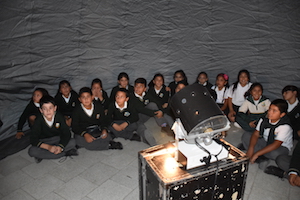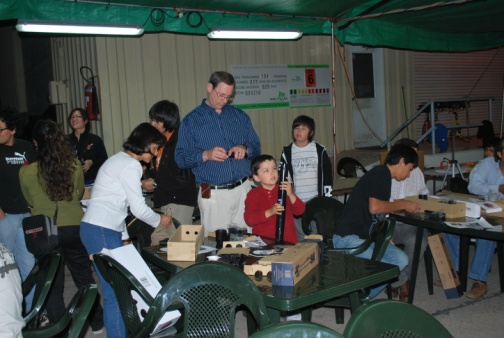

NOAO-S EPO Program
Besides the programs mentioned before: CADIAS [1], Dark Sky Education [2], Teaching with Galileoscopes [3], Visitor Center [4], Robotic Telescope [5], Media Relations [6] and Astro Chile [7]; there are Collaboration Projects, Intern students collaboration and Public Outreach.
Collaboration Projects
Many projects are carried out with collaboration of local and national institutions, such as Explora from CONICYT, the University of La Serena. Some examples are the National School Astronomy Congress and the International Amateur Astronomy Congress in 2009, each with the participation of 200 students, teaches and general public.
Intern students collaboration
The observatory recieves professional interns in differents areas each year, which offers the opportunity of their collaboration in activities organized by EPO. During the summer 2009-2010, there were 27 interns, who participated in 2 star parties, one organized by NOAO EPO team and another by Gemini.
Public Outreach
NOAO EPO, presented a project to make CADIAS the official insttution to train astronomical tourism guides in the region.
EPO/CADIAS participates in seminar and meetings. During 2007 it took part of 22 community events. In 2008, 25 events. In 2009, 31 events...
| MISSION
CADIAS mission is responsible at all levels for promoting the development of education, science and technology, through astronomy. It also promote full access of all people in the Region of Coquimbo to their facilities, through a system ensuring equal opportunities and quality learning. It also seeks to fully bind the citizen through the dissemination of astronomical knowledge in a didactic way, just like that stimulating research in various areas of knowledge. |
 |
| HISTORY
1998 In this year was realized the event “SEMANA ASTRONÓMICA (Astronomical Week)”, sponsored by AURA Observatory in Chile / Cerro Tololo Observatory, and by “Universidad de La Serena”. In this event participated “Colegio Francisco de Aguirre”, performing an exhibition in September with student works and supported with an exhibition of astronomical photographs and talks called "Starfall, the Leonidas" by Mr. Arturo Gómez, a leading astrophotographer of Cerro Tololo Observatory. On this occasion he invited the community to observe this celestial phenomenon would happen in November. The Student Network of La Serena is an organization formed in August 1999, to the Cultural, Educational and Scientific Project called "EL SOL NUESTRA ESTRELLA" organized by “Colegio Francisco de Aguirre” from La Serena, sponsored by AURA Observatory in Chile / Cerro Tololo Observatory, and sponsored by “Universidad de La Serena”, “Telefónica CTC” and “Diario El Dia”. In to date participate 9 schools. |
|
"This program is executed by EPO (Daniel Munizaga) to present to the public night sky images accomplished during visits to Tololo and other observatory sites".
Go to gallery [8]
Astro Chile is an EPO project, which began in 2002, result of the collaboration of Tucson and La Serena teachers and astronomers that promote the development of methodological innovations in the teaching of Astronomy, through videoconferences.
In 2008, the activities included 2 videoconferences workshop of 50 students and a lab session for 6 schools in Chile and 6 in United States.
In 2009-2010, 2 GAN (Globe At Night) videoconferences were performed with Tucson and La Serena school students.
Visit the Astro Chile page in NOAO site [9]
Dark Sky Education (in progress) Is an EPO Program.
It runs Globe at Night [10], an annual program to measure the sky quality with SQM (Sky Quality Meter) or naked eye, with the participation of students, teachers and general public. It has been developed in the Coquimbo Region for 3 years.
During the campaign of 2010, there were 67 schools participating with 83 teachers involved in training throughout the region. We also had the very special participation of teachers from Copiapó (3rd Region) and Antofagasta (2nd Region) from the north of Chile.
An introduction to Dark Skies/ Light Pollution [11]
Oficina de Proteccion de la Calidad del Cielo del Norte de Chile, OPCC [12] is the Northern Chile Skies Quality Protection Office
This EPO NOAO-South program is based on the "Teaching with Telescopes" program in NOAO-N.
Its goal is the training -which consist on the assembly of the galileoscope and an observing plan- and delivery of 500 Galileoscopes to local students community and staff.
It started in March 2010 with the NOAO-S staff, and it will continue with the Coquimbo region selected schools in September, October and November 2010.

by Leonor Opazo
(in progress)
Robotic Telescope Hugo E. Schwarz is an EPO NOAO-South project, whose goal is the refurbishing and updating the mount and dome of the Robotic Telescope donated by Las Campanas Observatory.
It began in 2008? in collaboration of the Universidad de la Serena (ULS) mechanical, electronical and physics students and voluntary participants of CTIO astronomers and engineers.
In 2008, 9 ULS students participated, divided in 2 teams: the first in the development of a new electronic drive system for the mount, and the second, dedicate to re-design the dome mechanism.
In 2009-2010, 3 students participated in this project's development.
Links
[1] http://www.ctio.noao.edu/noao/content/CADIAS
[2] http://www.ctio.noao.edu/noao/content/dark-sky-education
[3] http://www.ctio.noao.edu/noao/content/teaching-galileoscopes
[4] http://www.ctio.noao.edu/noao/content/public-access
[5] http://www.ctio.noao.edu/noao/content/robotic-hugo-e-schwarz-telescope
[6] http://www.ctio.noao.edu/noao/content/media-relations
[7] http://www.ctio.noao.edu/noao/content/astro-chile
[8] https://www.flickr.com/gp/138613652@N03/43LYq4
[9] http://www.noao.edu/education/astro/chile/
[10] http://www.globeatnight.org/
[11] http://www.ctio.noao.edu/noao/content/preserving-dark-skies
[12] http://www.opcc.cl/
[13] http://www.ctio.noao.edu/noao/sites/default/files/EPO/robotic-telescope.jpg
[14] http://www.ctio.noao.edu/noao/sites/default/files/EPO/robotic-telescope2.jpg